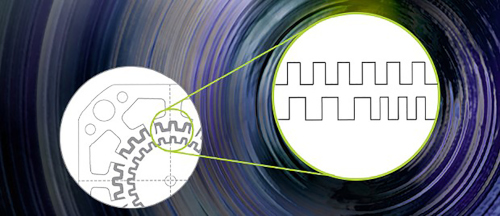
As OEMs strive to develop ever more mobile and compact machines, the trend is forcing miniature motion control manufacturers to maintain pace. Miniature motors and controllers are enabling precision performance control with an increasing need for reliability in demanding applications. The field is answering the demand with a shift towards embedded, decentralised architecture.
Gerard Bush of INMOCO explains how in meeting the demands, miniature motion technology is moving towards decentralised control.
The increased need for applications which are mobile, lightweight and compact has passed on these same requirements to designers of miniature motion control systems. Answering these demands, miniature motion solution development has also facilitated the reorganisation of machine architecture, allowing OEMs to decentralise motion control to local, embedded positions. As a result, in addition to machines with highly compact footprints, this trend is enabling improved performance, increased reliability and helping to reduce costs.
Reducing the size of the motor.
Brushless DC motors remain in favour for their high power to weight ratio and their ability to generate a constant torque up to high RPM. Alternatively, stepper motors are frequently used in portable applications as a result of their high torque to weight ratio. Despite the once detracting effect of a lowered effective torque because of their tendency to oscillate, the stepper servo technique has resolved the issue and uses an encoder to enable higher torque across the operating range of the motor, eliminating mid-range instability.
Particularly for steppers, as motor size reduces it becomes harder to add sensors without impacting the overall footprint. This explains the trend in sensorless operation for some applications using control techniques such as electronic stall detection for stepper motors as well as back-EMF for Brushless DC motors.
However, the challenge for sensorless techniques in many uses, such as electronic stall detection, can be to match the required level of reliability. This is pushing the trend for even very small motors to upgrade their sensors or to include encoders where they were not previously used. This demand for more robust sensors has also seen an increased trend for magnetic rather than optical encoders, especially when deployed in harsh conditions and medical applications.
Miniature motion control.
Whether using a motion control IC or a module, the most significant contributor to the size reduction in electronic motion controls is the performance increase of digital switching amplifiers. Most frequently, this means the metal–oxide semiconductor field-effect transistor switch, or MOSFET. Today, MOSFETs are reliable and compact, with significant improvements in energy losses to increase their efficiency.
Another advance has been in heat flow management and a new, specialized PCB, known as a metal clad printed circuit board (MCPCB) is gaining prominence for use in motion control amplifiers. It involves a traditional copper PCB which holds the integrated circuits onto a relatively thick aluminium or copper substrate. This layer acts as a dielectric layer which efficiently transfers the heat from the PCB. The MCPCB thermal transfer technology has accelerated the power density of motion control amplifiers and the latest generation devices achieve results of more than 100W per cc3.
The closer the better.
The more compact the motion control device, the greater the potential to deploy it locally or embed the motor and controller into the host machine. These embedded controllers can take the form of cable connected modules or an application specific control board built from PCBs or ICs. The control advantage of these devices, particularly those that integrate analogue sensors such as sin/cos encoders, is more accurate signals while the reduced length of physical communications means higher speed servo loops. These gains are augmented for ultra-high accuracy systems where performance is measured in nano or picometers.
As a result, the trend shifts closer towards the advantage of embedded motion control solutions versus those which are remotely mounted, especially for smaller machines requiring miniature motion control systems. Even though the current technology may not represent significant performance gains for large machines, even for these applications a single PCB-based embedded motion solution creates a more compact footprint compared to an external device.
Cost-wise, embedded control can be less expensive than module-based control providing a sufficiently high volume of devices are involved, but at the same time a new motion control device is easing the barrier to building application specific embedded control boards. Known variously as an intelligent amplifier, programmable amplifier, or motion control module, these PCB-mountable devices simplify custom control board design and development.
PCB-mounted motion control modules can run user application code, generate motion profiles, control servo positioning and drive the motor with an on-board amplifier. These devices can also interface via serial, CAN and Ethernet. Crucially they maintain the advantages of small size, measuring just 3-5cm in length and they can be interconnected, plug-and-play style.
Ever-shrinking motion control systems.
From drones to robots to patient treatment devices, compact and mobile applications continue to increase in number while the machines themselves decrease in size. Along with miniature motors, motion control electronics have not only reduced in size and weight but have increased in performance capability. Performance has also been able to advance with the greater potential of distributed architecture that local, embedded motion allows, at the same time increasing reliability with the potential to reduce cost.
“To get deeper technical insight, read the paper “Motion Control Goes Small” written by Chuck Lewin of Performance Motion Devices, Inc. (pmdcorp.com)”




